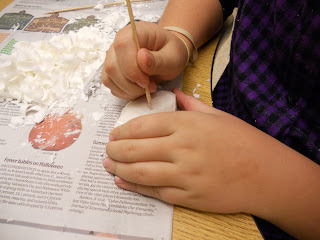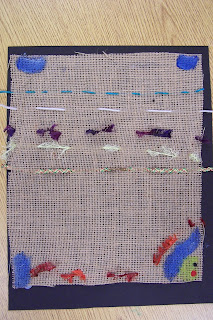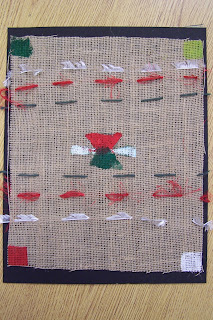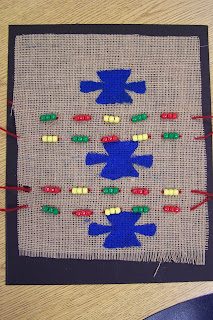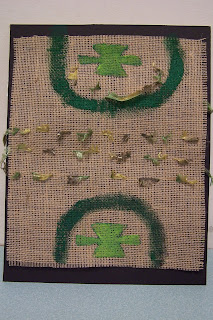Ooooh, I have a special treat for you today! Tooled metal ornaments inspired by Mexican folk art! They are so bright and shiny, the children just loved making them!
 |
| Mexican Folk Art Ornament |
When I am looking for inspiration for art projects, I look pretty much everywhere: my Art History books, gift catalogs, and magazines to name a few of my sources. My grandmother loves to bring me magazines that she's done with. No matter how old the magazine is, I love to look through them for techniques and inspiration. This craft was originally published in "Crafts" magazine in 1984. I loved the look of these ornaments and thought my art kids would love to make them. I was right! They LOVED making these. I had them make little cards to put them in so they could give them to a loved one as a gift.
The tooling aluminum needed to be ordered online from www.dickblick.com, but it was so worth it! I ordered a roll for just under $6 and combined with a couple of other things, shipping was only $7. I know that seems like a bit much, but I did have a few things in my order and the tooling aluminum is a roll of 15' or so, enough for plenty of ornaments! Plus, it is a medium that is unusual for the children to work in. I highly recommend it! So, let's get started!
Supplies Needed:
- Tooling aluminum, available from www.dickblick.com
- Newspaper
- Dull pencil or blunt stick for tooling the design
- Sharpie markers or other permanent felt tipped markers in a variety of colors (I had an eight color assortment available, but so many beautiful colors are available!)
- Hole punch
- 8" piece of ribbon for hanging
If you would like to make this as part of a card, see the end of this post.
Directions:
1. Choose a design for your ornament, we used the full size ornament patterns that were published in "Crafts" magazine, but I also had a few blank ornament shapes available for children to design their own. I encouraged the children to design bold designs with clear, large shapes. I also told them to fill up the entire ornament shape and add some details to their design (tons of little details may get lost, but I didn't want them to just draw one little shape in the middle of the ornament and say they were done). Just to be sure they created designs that would work, I had them show me their drawings "for approval" before they started tooling.
2. Using scissors, cut a piece of the aluminum roughly the size of your ornament. We used 4 1/2" x 6" rectangles. Tape the paper with your ornament design to the aluminum to hold it in place while you work.
3. Place the aluminum onto a pad of newspaper. This will create a soft surface for the metal. Using a dull pencil and firm pressure, trace over all of the lines of your design.
4. Once your design is done, use scissors to cut out the shape of the ornament. I found that younger children had trouble with this part and sometimes the ornament would get all bent up or the outer shape would become distorted. So if you are working with younger children, you may want to cut the ornaments out yourself.
5. Flip the ornament over and gently color the raised surfaces with permanent markers. The children can create large areas of color and then add details with a darker color on top. Encourage doing one's best work, taking one's time and adding details and pattern.
6. Once done, have the child add his/her name and date to the back.
7. Use a hole punch to create a hole for hanging and add ribbon to hang the ornament.
8. Attach to a card if desired. See my card directions, below. Feliz Navidad (Merry Christmas)!
 |
| Some of the ornaments done my my students |
----------------------------
To make this project into a card:
Additional Supplies Needed: you'll need construction paper for the card, an envelope, tape to adhere the ornament to the card and the optional information for inside the card (see the info later on in the post).
Cut a piece of construction paper so that it fits inside the envelope you have. Inside the card, glue the greeting and the information about the project. Have the child sign the card.
The greeting I used was:
Feliz Navidad, próspero año y felicidad!
(Merry Christmas, a prosperous year and happiness)
May the Spirit of the season bring you joy
and peace.
I also included this information on the card:
Tooled Metal Ornaments
Congratulations! You are the
proud recipient of a hand-tooled and hand-colored metal ornament. These
ornaments are done in the style of Mexican folk art with markers standing in
for the traditional paint. The children used tooling aluminum from www.dickblick.com, pressing their designs
into the metal with a dull pencil, then added color with permanent Sharpie
markers.
Care of your ornament: the
tin is bendable, so care should be taken to keep it from being crushed. It
should also be hung up away from little ones since the marker could come off if
the ornament is chewed on and the edges are a bit sharp for delicate fingers.
Use tape to attach the ornament to the front of the card and draw a "frame" around the ornament with a felt tip marker to fancy up the front of the card. Done!
Note: if you are going to write a name on the front of the envelope, do so before you put the ornament in the envelope or you will ruin the ornament. Also, take care not to fold or bend the ornament--the metal is pretty thin and will crush and/or bend easily. If you want to mail this card, you'll have to put it in a crush- and bend- proof package.








